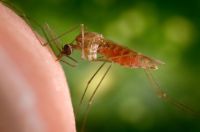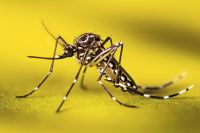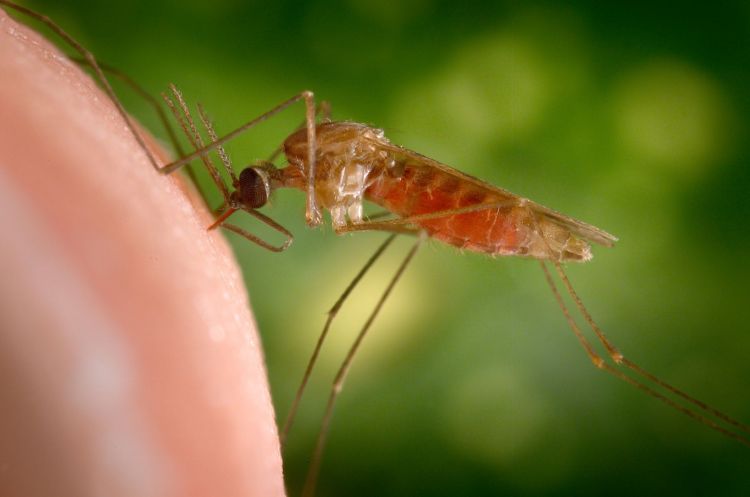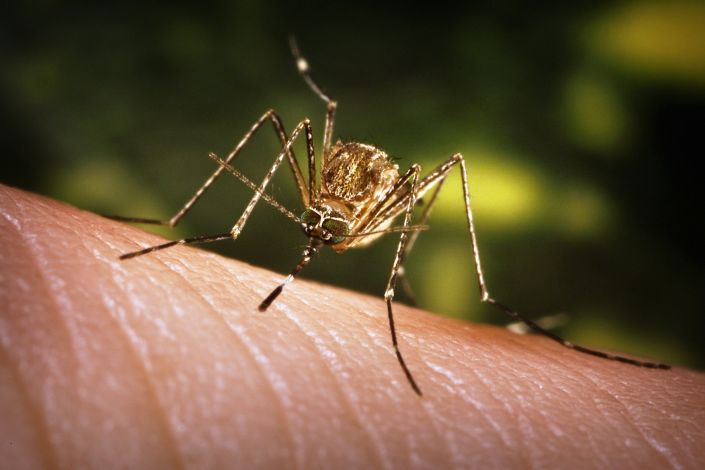
This photograph depicts a female Aedes aegypti mosquito, which is the primary vector for the spread of Dengue fever. This July, the World Health Organization warned that climate change could push dengue cases to near-record numbers. (Image credit: James Gathany/CDC)
The changing climate is dramatically altering the landscape of mosquito-borne diseases. Warmer temperatures, changes in rainfall, and human activity are enabling their spread to new places often unprepared to deal with them.
This year, locally transmitted malaria cases cropped up in Florida and Texas for the first time in 20 years. But dengue fever has dominated global headlines, with outbreaks unprecedented in their locations, severity, and duration. With deadly outbreaks from Bangladesh to Peru and record numbers of cases in Europe, the World Health Organization officials this July warned that climate change could push dengue cases to near-record numbers.
“Often people think that all mosquitoes are the same, or that all mosquitoes can transmit the same diseases, but in fact mosquitoes differ in their ecologies and their ability to transmit different pathogens, resulting in differences in how we prevent and mitigate disease transmission,” said Erin Mordecai, associate professor of biology in the School of Humanities and Sciences.
Mordecai is among several Stanford experts who are leading efforts to understand how climate change is impacting the spread of various mosquito vectors and the deadly diseases they carry – and how to respond. Educating communities and health providers about the differences between these various mosquitoes on the move is critical to protecting public health, they say.
Mordecai joined Desiree LaBeaud, professor of pediatrics at Stanford Medicine, Joelle Rosser, an infectious disease instructor, and Eloise Skinner, a senior scientist in the Mordecai Lab, to speak with the Stanford Center for Innovation in Global Health about how the burden of mosquito-borne disease is shifting, and how communities can prepare.
1. What worries you most about mosquito-borne diseases in light of rising temperatures and environmental changes?
LaBeaud: I worry about Aedes aegypti. These mosquito vectors spread a lot of diseases such as dengue, chikungunya, Zika virus, and yellow fever. Everything we’re doing as we alter our world puts us more at risk: They breed in the plastic waste we discard; they thrive in urban environments, and they like it hot. They’re also fairly sneaky. It’s hard to find them when they’re resting, so you don’t know where to spray. We’re also much less prepared for the diseases they spread, particularly dengue, than we are for malaria.
Mordecai: The biggest part of this story, in terms of numbers of cases and people affected, is probably dengue and the related viruses that are being transmitted by the same Aedes mosquitoes. If you look at the data on how they’ve changed over time, you see basically exponential growth in the last 30 years over almost every region where those diseases exist.
Skinner: Vector-borne diseases in general have been shaping humanity for centuries. So we expected outbreaks, but we didn’t necessarily expect the intensity we’re seeing now. Nor did we expect to see these vector-borne diseases like malaria, West Nile, and dengue, all with very different transmission cycles, hosts, and habitats, hitting different places at different times. Climate change is impacting all these multiple layers of the transmission cycle.
Mosquitoes to watch

Anopheles
(Image credit: James Gathany/CDC)
- Diseases: Mosquitoes in this genus, such as Anopheles gambiae in Africa and Anopheles quadrimaculatus in the United States, are best known for spreading malaria, a leading cause of death and disease in many countries.

Aedes
(Image credit: Amy E. Lockwood, MS/CDC)
- Diseases: The best known mosquito in this genus may be Aedes aegypti, which spreads numerous serious diseases, including dengue fever, chikungunya, Zika virus, and yellow fever. Aedes albopictus, the Asian Tiger mosquito, also spreads numerous diseases including dengue and West Nile virus.

Culex
(Image credit: James Gathany/CDC)
- Diseases: Mosquitoes in the Culex genus are well established in the United States and spread West Nile Virus in addition to other diseases such as St. Louis encephalitis.
2. What do we know about how environmental changes are increasing mosquito-borne disease?
Mordecai: Climate is just one layer in the conditions that lead to a disease outbreak. Other layers include human activities that increase our exposure; presence of the parasite or virus the mosquitoes spread; and human susceptibility (lack of immunity). This makes it challenging to attribute vector-borne disease to climate change in the precise way that scientists can now do for heat waves and hurricanes. But I think we’re getting really close. And climate suitability is very important because it’s always the fundamental thing that determines whether conditions are suitable for an outbreak.
Rosser: Climate change increases the frequency and intensity of both flooding and drought – and both can increase the risk for diseases such as dengue fever. Floodwater pooling in small containers makes an ideal breeding ground, while during drought, people store water in small containers, which also become breeding grounds.
LaBeaud: We’ve recently learned that plastic waste makes an excellent breeding ground for the Aedes aegypti mosquito – and plastic trash is everywhere. Less than 10 percent of the world’s plastic is recycled, and much of the rest ends up in landfills in other countries. When I purchase a plastic drink container, I remind myself that if I don’t reuse it or deal with it myself, it’s going to end up somewhere else in the world, breeding mosquitoes that will bite vulnerable children and make them sick. The choices we make can impact people far away.
3. What are some changes we can expect with warmer temperatures?
Mordecai: My lab has identified the range of temperatures that is most suitable for malaria. Scientists used to think that hotter was better, but we now know that the climate is most suitable at about 25 degrees Celsius (77 degrees Fahrenheit). Climate change could assist in eradicating malaria in some places while driving new outbreaks in other places that lack the capacity to control malaria.
The thermal optimum for dengue is a much warmer 29 degrees Celsius (84 degrees F), which is why most places on the globe are becoming more suitable as global temperatures rise. The thermal window for West Nile peaks around 24 or 25 degrees Celsius (75-77 degrees F). We could see temperate zones becoming increasingly suitable for West Nile, and we could see transmission seasons extend earlier in the spring and later into the fall.
4. How can communities prepare?
LaBeaud: Large outbreaks can be overwhelming to public health infrastructure in places, like Peru, that are not used to dengue. Often, many nearby countries are dealing with the same viral outbreak, so coordinating health agencies like the Pan-American Health Organization become very important in terms of providing a more centralized and rapid response and offering support for surveillance and diagnostics. Effective public health education is also important: You have to educate the healthcare providers, ministry of health officials, and community members themselves that all vectors are not the same.
Rosser: We need to anticipate climate change’s enormous impacts and start co-designing and testing ways to make communities more resilient. This could look like providing education about dengue risk factors such as trash and standing water, then working in tandem with communities to co-design solutions to decrease risk.
As COVID showed us, figuring out ways to reduce disease transmission in vulnerable populations and hotspots helps limit the spread to everyone.
Mordecai, LaBeaud, and Rosser are faculty fellows at the Stanford Center for Innovation in Global Health. Mordecai and LaBeaud are senior fellows at the Stanford Woods Institute for the Environment. Mordecai is a faculty fellow at the King Center on Global Development and a member of Stanford Bio-X.
Media Contacts
Jamie Hansen, Stanford Center for Innovation in Global Health: jmhansen@stanford.edu


